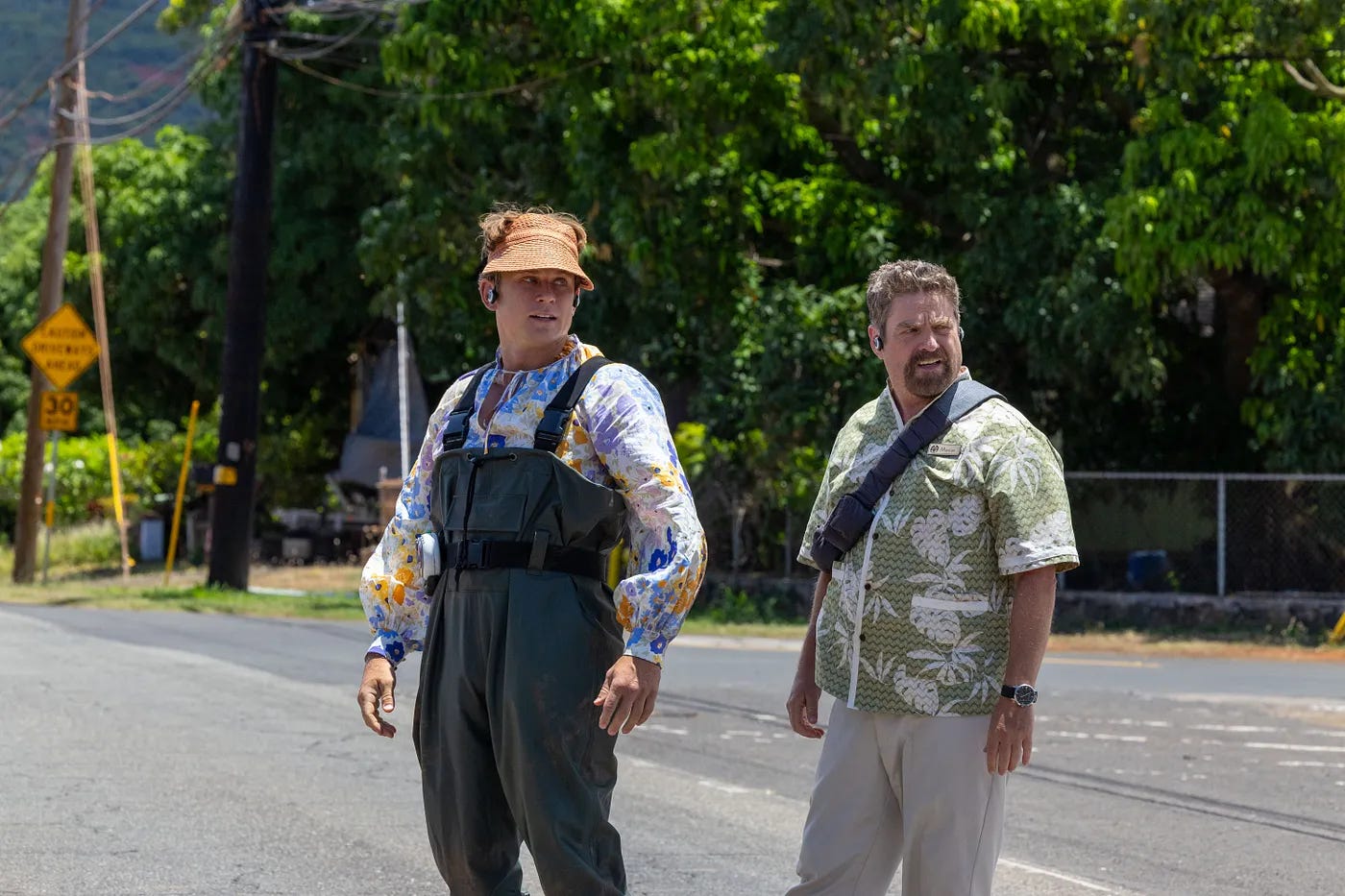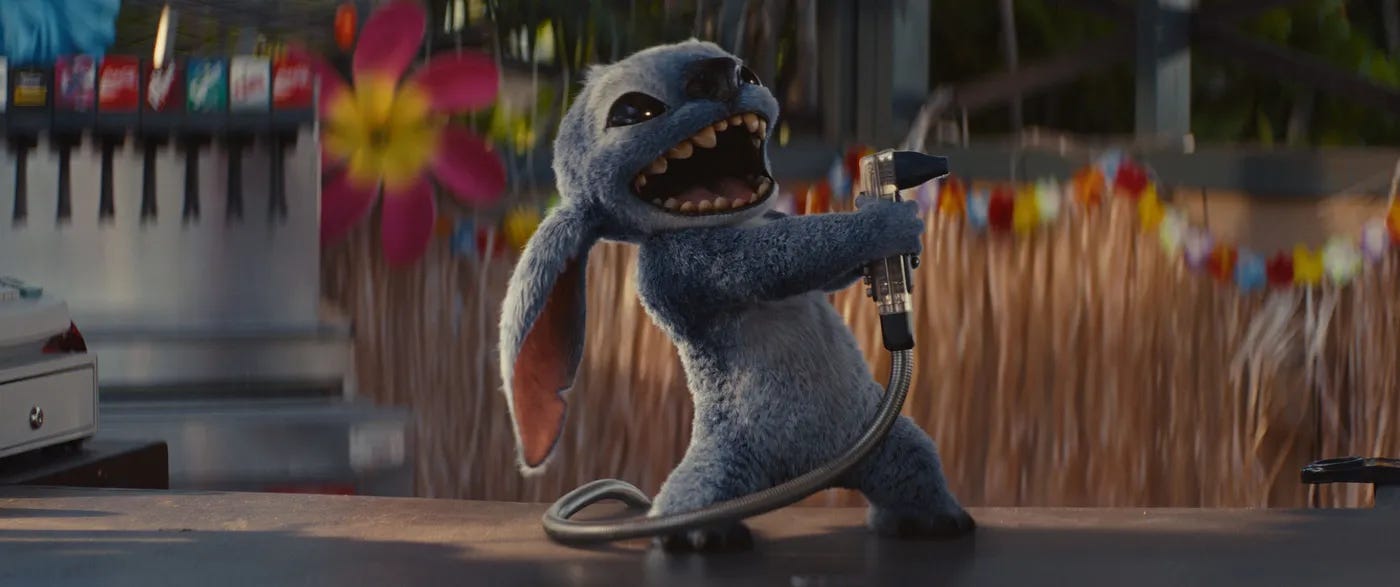Review: 'Lilo & Stitch' (2025)
"Broken, but still good."
When Disney’s Lilo & Stitch first premiered back in 2002, at the tail end of the massive studio’s hand-drawn 2D animation era, it became an instant hit. The film was written and directed by filmmakers Dean DeBlois and Chris Sanders, who voiced the character Stitch.
It broke many of the up-until-then expected norms of the mainstream animation genre. There were no Disney princesses, no love interests, no spontaneous singing. Instead, it focused on a broken Hawaiian family and their encounter with an outcast alien.
Outcasts and misfits are common themes in Chris Sanders’ films. He’s behind some of my favorite animated movies ever: The Wild Robot, How to Train Your Dragon, and yes, the original Lilo & Stitch. These stories often revolve around those who don’t fit in and the idea of a “found family” in a way that sheds many of the cliché tropes found in children’s films. One could argue that Chris Sanders’ stories are more realistic and relatable as they explore an imperfect world and the imperfect people — human, robot, or alien — who live in it.
While Lilo & Stitch has appeared in several spinoff titles for TV since the original film first premiered in 2002, it’s been over two decades since we’ve seen that odd couple on the big screen. And now it is Lilo & Stitch’s turn for the live-action treatment.
And yes, I can almost hear some of you, those who categorically dismiss every animation-to-live-action adaptation, lamenting Disney’s sacrifice of creativity on the altar of the almighty dollar while reciting some well-worn speech about nostalgia and artistic bankruptcy.
And while these sentiments might ring true for several of the live-action adaptations (truly, I won’t mention titles, but some of them we didn’t need, right?), it’s far from the case with all of them.
Now, I could spend more time in this review writing about Disney’s live-action adaptations, how they work (and how they often don’t), and where Lilo & Stitch fits into all that. I could give you examples of which ones succeeded and which ones flopped, if not financially, then in the eyes of grumpy adults with an “everything was better when I was young” thing going on.
Despite being updated to reflect the times we live in, these live-action remakes often tell the exact same story as their animated originals. They’re resurrected using the same visual toolbox as the next live-action adaptation and aimed at a new generation of moviegoers, who, I might add, are often the same age we were when we first watched the originals of these films.
In the end, what you think of any given remake usually comes down to perspective, nostalgia, and sheer stubbornness. And I’m sure plenty of other reviews across the internet will take that familiar route, sticking closely to the expected film review formula.
That’s why I’ll do something different. I’m throwing out any expected disposition or standard film review setup I might have. Instead, I’ll start by telling you a story. One quite personal that definitely shapes how I see Lilo & Stitch.
So imagine this Norwegian film and TV critic, now one of those grumpy forty-somethings, almost fifty, who fell into the boiling cauldron of film, TV, and pop culture at an early age. This critic didn’t have the easiest teenage years, but he’s not complaining too much. The same could be said about a lot of Gen X’ers who, I might add, were young once, too. Yes, it’s true. Imagine that.
While he might not have had a clear vision of what he was doing at the time, for various reasons, after finishing school, he needed to get as far away from Norway as he could think of. The option that landed in his lap was Pacific University College in Hawaii.
Now, this film and TV critic might have been a bit too eager — or foolish — to escape Norway, widely considered one of the best places in the world to live. But in The Great Book of Moody Teenagers, there seems to be a rule: “Thou shalt rebel against thy family.” So rebel he did. He flew off to the magical land of Hawaii on the other side of the world, expecting all his problems to disappear, but bringing his grudges toward his family with him.
It turns out that being on the other side of the world in a strange place (and yes, the USA can be strange to an outsider) isn’t that easy. While he fell in love with Hawaiian culture, he still experienced culture shock and hostility from his fellow students from the mainland USA, who treated him as something strange and weird—an outcast.
But after several months in Honolulu, where he had some difficult experiences, the teenager, who was really in his early 20s by that time, realized he actually missed his family. And he went home, tail between his legs. But emotionally, parts of the Hawaiian culture came back with him.
So when Chris Sanders and Dean DeBlois gave us Lilo & Stitch a couple of years later, the film and TV critic, by that point in film school, was hit with a wave of strong emotions. Nostalgia, longing, love… it was like nothing he had seen before. A story about an outcast stranded in Hawaii, with a strong theme of families lost and found, centered on someone trying to fit in despite being different and misunderstood. It hit him right in the heart. It also became one of the films that supported him through a rough time.
That was long ago.
With such a strong connection to the original Lilo & Stitch, hearing about the upcoming live-action remake gave me a lot of mixed emotions. Would I finally get to see my favorite Disney character, Stitch, in live-action? How would that feel? Did I even want to? The character design in the original is perfect, but also so over-the-top that it might easily fall into the typical traps of live-action adaptations, where filmmakers struggle to find the balance between comical and realistic. And when they do find a balance, it often lands right in the dreaded uncanny valley.
But let’s reel this in a bit, shall we? I’m sure you know the story of Lilo & Stitch. But in case you don’t, here’s a refresher, with the names of the actors for the new version.
Our story begins in outer space, where the Galactic Federation, a collection of various alien species led by the Grand Councilwoman (Hannah Waddingham), is holding a trial. The mad scientist Dr. Jumba Jookiba (Zach Galifianakis) stands accused of creating a bio-engineered, lethal monstrosity capable of massive destruction: Experiment 626 (Chris Sanders, who also voiced him in the original). Both creature and creator are on trial.
When Experiment 626 escapes custody right after the trial and flies a stolen police spaceship to Earth, it’s not just a matter of destroying the planet, which, according to Earth expert Agent Pleakley (Billy Magnussen), is a colony of near-extinct mosquitoes. Instead, to preserve the mosquito population — and their important human food source — Dr. Jumba and Agent Pleakley are sent to retrieve the creature, using holographic disguises.
Meanwhile, having crash-landed on Hawai’i (The Big Island) and disguised himself as some kind of bizarre koala-like dog, Experiment 626 soon finds himself in the company of two recently orphaned Hawaiian sisters: young Lilo (Maia Kealoha) and big sister and legal guardian Nani (Sydney Elizabeth Agudong), who are living in a run-down house and just trying to make sense of their new lives after their parents died in a traffic accident.
With the chaotic and destructive Experiment 626, now named Stitch, in their lives, their situation becomes more challenging as Nani struggles to find work to provide for her sister. But soon, the three learn to live together and find a sense of family and belonging in each other.
But Stitch is a wanted creature, and the megalomaniac Dr. Jumba and the overly positive mosquito enthusiast Agent Pleakley have also landed, hunting for Stitch. And if you’ve seen the original, you know where this is going; the rest of the story is a jumble of shenanigans and gags, along with a whole lot of heart, as the sisters and their adoptive alien must find a way to preserve their small, “broken, but still good,” family before the social workers Mrs. Kekoa (a new character played by Tia Carrere, who voiced Nani in the original) and Cobra Bubbles (voiced by Ving Rhames in the original, but played Courtney B. Vance in the new version), who might not be a real social worker, take Lilo away.
So, with the special place this film holds in my life, how could a live-action adaptation ever work for me? Well, those of you who read my reviews will know that I’m generally quite positive and open to new takes on familiar titles, so yes, I liked this. Generally.
This new live-action remake does suffer a bit from the cartoon vs. realism style. The aliens are, for the most part, familiar to those who have seen the original, only in a more photorealistic style. They are, however, easily recognizable as CGI. But luckily, unlike the nightmare fuel that is the dwarves in the live-action adaptation of Snow White, they never try to look human, so it works much better.
But the main attraction here is, of course, Stitch himself. The blue, six-armed, koala-dog-alien-creature is excellent in this version. Voiced by Chris Sanders, he’s just different enough from the original to make him interesting in live-action, and he has a great range of expressions. But the real test is whether the emotional range he had in the original comes through in live action, and I’m happy to say that it does. His chemistry with new actor Maia Kealoha, who plays Lilo, also works. And while many of their gags and shenanigans have been changed from the original (no Elvis on the beach, for instance), it’s all still fun.

However, the film gets a bit caught up in its own comedy sometimes. There’s more focus on Zach Galifianakis and Billy Magnussen as Dr. Jumba and Agent Pleakley, with a lot of gags and culture clashes. I was reminded of the Men in Black films in some of these “He’s obviously an alien!” moments. But these jokes don’t always land, even if there are several fun scenes with a portal gun (fans of the Portal games, rejoice!).
But in the end, it’s a fun ride — and one of the more satisfying live-action adaptations I’ve seen from Disney. It’s far from perfect, but I had a genuinely good time with it. It’s “broken, but still good,” as they say. No, it doesn’t measure up to the original, and it probably won’t convert the more stubborn critics of Disney’s live-action remake spree.
But it doesn’t need to. The original is still right there (we rewatched it just two days ago as of this writing), and I’m glad a new generation — one that sees 2D animation as practically prehistoric — will still get the chance to meet Lilo & Stitch — even if it’s not in the original.








